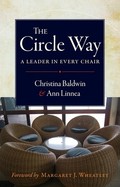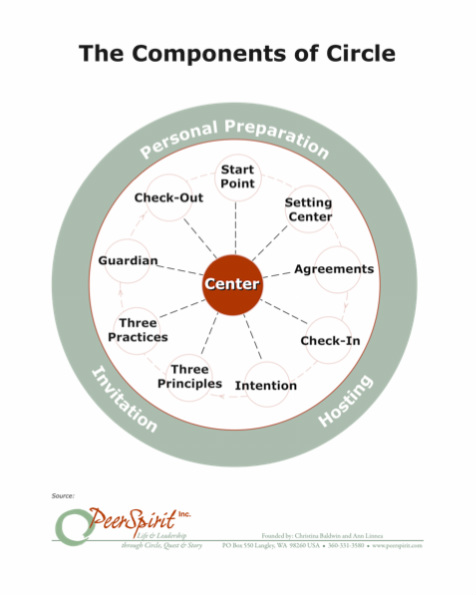Circle
|
The Circle, or council, is an ancient form of meeting that has gathered human beings into respectful conversations for thousands of years. In some areas of the world this tradition remains intact, but in some societies it has been nearly forgotten. PeerSpirit circling is a modern methodology that calls on this tradition and helps people gather in conversations that fulfil their potential for dialogue, replenishment, and wisdom-based change.
One of the beautiful things about circle is its adaptability to a variety of groups, issues, and timeframes. Circle can be the process used for the duration of a gathering, particularly if the group is relatively small and time for deep reflection is a primary aim. Circle can also be used as a means for “checking in” and “checking out” or a way of making decisions together, particularly decisions based on consensus. Be creative with circle! Principles of Circle
Practices of Circle
General Flow of the Circle
Intention shapes the circle and determines who will come, how long the circle will meet, and what kinds of outcomes are to be expected. The caller of the circle spends time articulating intention and invitation. Welcome/Start Point. Once people have gathered, the circle host (or a participant) will typically open the circle with a gesture to indicate that the circle will start. Poems, silence, song, or gesture may be used. The center of a circle usually holds objects that represent the intention of the circle. Check-in usually starts with a volunteer and proceeds around the circle. If an individual is not ready to speak, the turn is passed and another opportunity is offered after others have spoken. Setting Circle Agreements. The use of agreements allows all members to have a free and profound exchange, to respect a diversity of views, and to share responsibility for the well-being and direction of the group. Agreements often used include:
To aid self-governance and bring the circle back to intention, having a circle member volunteer to be the role of guardian is helpful. This group member watches and safeguards the group’s energy and observes the groups process. Closing the circle by checking out provides a formal end to the meeting, a chance for members to reflect on what has transpired. (The above was adapted from a handout which was generously provided by Peer Spirit to the Art of Hosting) What is Circle Good For? One of the beautiful things about circle is its adaptability to a variety of groups, issues, and timeframes. Circle can be the process used for the duration of a gathering, particularly if the group is relatively small and time for deep reflection is a primary aim. Circle can also be used as a methodology of “checking in” and “checking out” or a way of making decisions together. Be creative with circle and be ready for the deep wisdom it can unearth! Materials Needed:
|
PeerSpirit Circle process
| ||
| peerspirit-circle-guidelines2010.pdf |
Further resources
PeerSpirit, run by Christina Baldwin and Ann Linnea is the steward of the form of circle used most widely in the Art of Hosting community worldwide.

The Circle Way: A Leader in Every Chair is the definitive guide to using this method.
Several videos have been co-produced by the Circle Carriers Legacy Project. There are three videos that describe the Components of the Circle Way, and these provide a helpful introduction and orientation to the Circle Way process:
The other video currently available is a Celebration of the Circle Way, to see where the Circle Way is being used in a variety of settings in North America for diverse purposes. A second celebration video is in production that showcases Circle Way stories from Europe and Australia.
- Part 1 describes Invitation, Host, Centre, Start Point, Agreements, and Check-in.
- Part 2 describes Intention, the Three Principles and Three Practices.
- Part 3 describes the Three Forms of Council, Talking Piece, Guardian, Scribe and Check-out.
The other video currently available is a Celebration of the Circle Way, to see where the Circle Way is being used in a variety of settings in North America for diverse purposes. A second celebration video is in production that showcases Circle Way stories from Europe and Australia.


